A visit to Pichler Klimabloc production facility in Wels, Austria
| 24 July 2010 - Comments (0) | Construction |
 Klimabloc is produced in Serbia by Zorka Opeka but the technology is coming from Austria. The mastermind behind Klimabloc is Markus Pichler, who is running a family business (that was created over 200 years ago) producing bricks in Wels, Austria. We had the chance to visit this state of the art production facility of Klimabloc as well as the new production line for prefabricated brick walls called REDBLOC.
Klimabloc is produced in Serbia by Zorka Opeka but the technology is coming from Austria. The mastermind behind Klimabloc is Markus Pichler, who is running a family business (that was created over 200 years ago) producing bricks in Wels, Austria. We had the chance to visit this state of the art production facility of Klimabloc as well as the new production line for prefabricated brick walls called REDBLOC.
Raw materials
Making Klimabloc starts by extracting the right raw material in clay pits nearby the factory. In fact, Klimabloc is made up of a mixture of several materials:
- 44% clay (from a loam pit)
- 44% marlstone (from a marl pit)
- 10% paper sludge
- 2% coal powder

Clay from the loam pit store before processing (photo Beodom).
Raw materials are extracted when weather permits and stored on the factory site. Having a secure supply of several weeks allows the block production to run continuously.
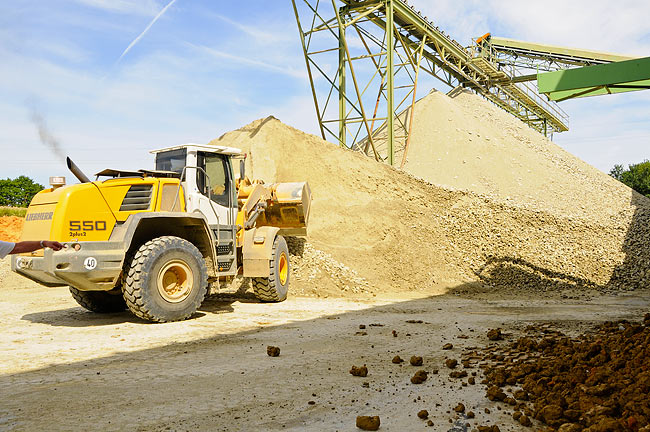
Marlstone being pickup to be processed (photo Beodom).
The paper sludge burns during the firing of the blocks and gives them a porous structure that improves their thermal characteristics. The coal also burns during the firing of the blocks and that evenly spread fuel improves the burning process while reducing fuel demand in the Kiln.

Paper sludge stored before processing (photo Beodom).
Eventually, all 4 raw materials are put together in the right proportion by the wheel loader and start their way through the processing.
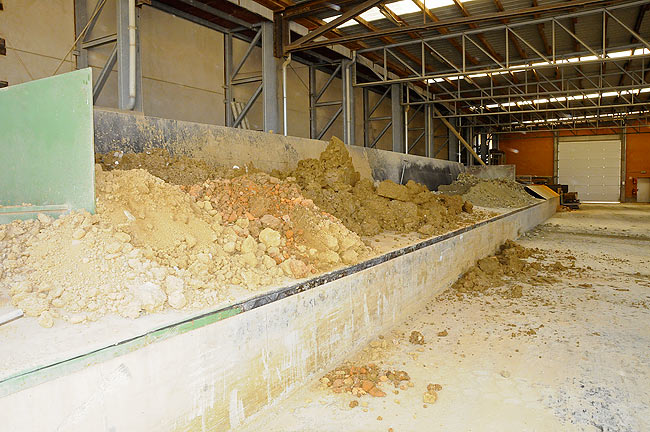
Raw materials put together before processing (photo Beodom).
Processing of the raw materials
The goal of the processing is to screen, mix, crush, grind and mill the raw materials in order to obtain a homogeneous mixture with particle size not exceeding 1 millimeter.

Mixing and crushing clay and marlstone (photo Beodom).

Grinding and milling the mixture in the panmill (photo Beodom).
Finally, the finished mixture is brought into a storage hall where it will be picked-up for making blocks.

Storage hall for the finished mixture (photo Beodom).
Making blocks
From the storage hall, the fine mixture is picked up, and passed into a machine that filter out eventual root pieces. Little water is added to make a dough that is sent to be extruded.

Preparing extrusion: removing root pieces and turning fine mixture into a clay dough (photo Beodom).

Pieces clay being sent to extrusion (photo Beodom).
The clay is heated up with steam and sent through a die piece to be extruded into the right shape. Different die pieces are used to created different block types.

Extrusion of the clay into the shape of a block (photo Beodom).

A die for the extrusion of a block 50 cm (photo Beodom).
The continuous extruded shape is cut precisely into blocks of the right dimensions. In fact, as the blocks will be rectified after burning, their height at this stage is few millimeters more than their final height.

Cutting blocks in the right dimensions after extrusion (photo Beodom).
Drying blocks
The blocks are delicately put onto dryer pallets that will be piled up and sent into the dryer room where they will slowly dry at 90°C.

Putting freshly cut blocks onto the dryer pallet (photo Beodom).

Pilling up dryer pallets before to be sent into the dryer (photo Beodom).
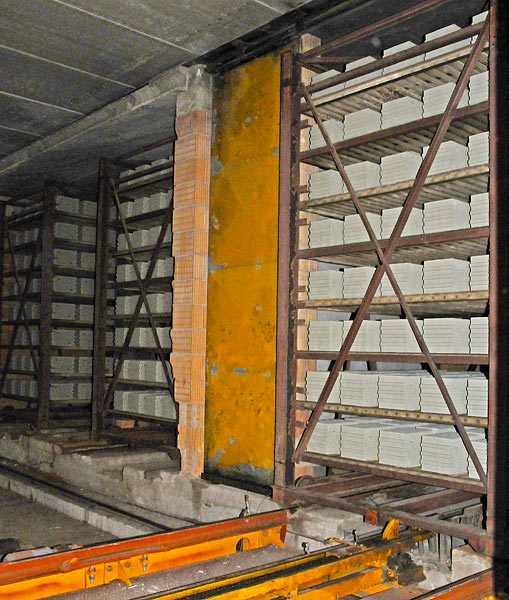
Blocks drying inside the dryer (photo Beodom).
Burning blocks
After the dryer, dry blocks are picked up from the dryer pallets and pilled up onto kiln carts that will be driven through the kiln during the burning process. Once dry, blocks are already very hard and that is the reason they can be pilled up without problem.

Dry blocks being piled up onto kiln carts (photo Beodom).
Kiln carts are driven thought the entrance of the kiln. Blocks will burn in the kiln at 950°C. The kiln uses natural gas as a fuel.
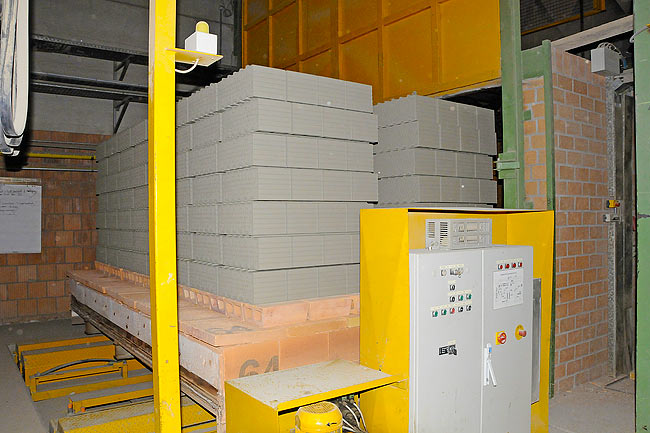

Kiln carts with block 50 being led into the kiln (photos Beodom).

View from the top of the kiln (photo Beodom).
Rectification of the blocks
Once blocks exit the kiln, the last step consists to rectified them. Unlike Klimabloc in Serbia, most of Klimabloc produced in Austria is rectified. These blocks can be used with thin join (join that is 1 millimeter thick) or glue (such as DryFix).

The production line doing rectification, here working on special blocks for storing bottles (photo Beodom).
The rectification is done in 2 steps by passing each block through diamond blades that shave off 1 or 2 mm on each side to make them to the perfect size.
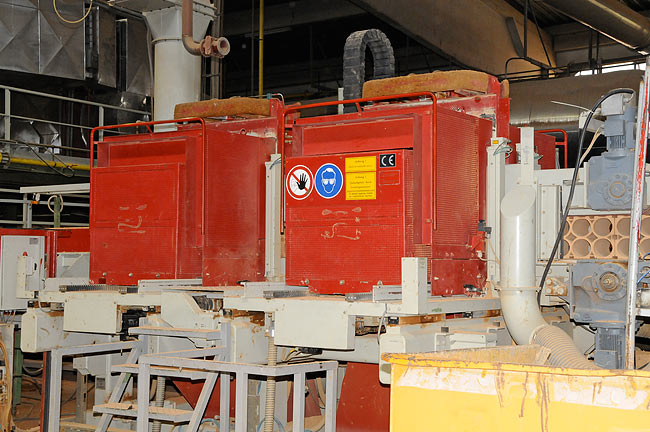
2 steps rectification of the blocks (photo Beodom).
Packing, labelling, storage and shipping
Finally, blocks are placed on pallets, shrink-wrap and the pallet is labelled. Pallets are stored outside in the storage space, where they will wait for shipment.


Storage of Klimabloc in the storage space of Pichler Klimabloc factory (photos Beodom).


Klimabloc pallets being loaded in a truck for shipment (photos Beodom).
Video of the production
A very informative video of the complete production of Klimabloc from extraction of the raw materials to shipment has been made by Pichler company. You can watch it below.
REDBLOC production
Besides KLIMABLOC production, we also visited the new REDBLOC facility making prefabricated walls using KLIMABLOC. A very impressive system.

The production line of REDBLOC (photo Beodom).
REDBLOC is a complete system to prefabricate walls made of rectified blocks on a automated production line. Starting from the architectural plan of an object, the object is analyzed to determine the different wall sections that will be built in the factory. The prefabricated walls are then shipped to the construction site where they just need to be assembled. The speed of construction with this system is unmatched. Quality is constant, windows and doors opening are done to the millimeter and electrical installation is prepared.


High pressure water cutting of the REDBLOC wall (photos Beodom).
REDBLOC has been made available in 2005 and is the result of several years development by Markus Pichler and partners. One of the key aspect of REDBLOC is the 2 components glue that is used to join blocks together. That glue dries in only 15 minutes and allow a freshly made wall to be cut and transported right away.

REDBLOC wall after cutting (photo Beodom).
Once cutting is finished, each wall element is secured with 2 metal strings that are positioned relatively to the center of gravity of the wall. Then the wall element is transported to a platform that will be shipped to the construction site.

Bringing REDBLOC wall to the shipment platform (photo Beodom).

REDBLOC walls and lintels on the shipment platform (photo Beodom).
REDBLOC is a real break through in the construction of solid walls as you can see in the 2 videos below:
REDBLOC prefabricated walls production
REDBLOC prefabricated walls installation
Serbia is not quite ready for a system such as REDBLOC but it represents a natural evolution and a rationalization of the construction process. First step in Serbia is to develop the market of blocks such as Klimabloc. The next step would be to introduce rectified blocks and glue such as DryFix. This would already be a great progress.




































